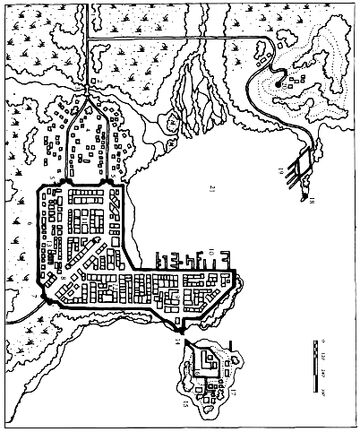
Súthure Map
- Type: Fortified City.
- Inhabitants: 95% Dunnish . 5% Cardolandrim.
- Population : 6,000.
- Origin :Founded by the adventurer Gordaig in T.A.1503 on site of a Dúnadan fortress.
- Purpose :Administrative center for the Kingdom of Saerlann; a meeting place for Dunnish tribes; a toll and supply station for Gwathló River traffic.
- Symbol :Black Battle-axe on a Yellow Ground .
Súthure (originally Rh."Sunthra Unsar") had also been known as Mistalonde and Lond Gwathló.Originally built under the name "Mistalonde", the old name for the city of Suthúre in Minhiriath appeared in any records from the mid Second Age until the capture of the city by Gordaig of Saerlann in T.A. 1503 who renamed it "Sunthra Unsar" after his father Sunthra.After it had been rebuilt the old cardolandren city became the seat of power of the Saerlannish clan or Dynion.Almost all of the inhabitants were Dunnish in origin. A flood of Plague refugees created political tensions in the region, and a revolt against King Laneig had succeeded in gaining control of most of the city.
Sunthra about T.A. 1640[]
Sunthra at this time is crowded with Eriadoran refugees fleeing the Warlord Ardagor, whose forces have raided to within two days march of the town. Unless otherwise noted, all of the town is controlled by the rebel forces loyal to Olby.
I. Gwathló Road. The road roughly follows the bank of the river from Tharbad, then takes a loop inland to bypass the swampy delta of the River Minsiril before closing to the Gwathló again at Sunthra. West of town, it sends one branch inland and another down the Gwathló to the coast of the Bay of Minhiriath.
2. Toll House. A squat granite fort.
3. Wooden Bridge. Gives entry to Sunthra over the Lenshir Stream. Occupied by Olby's people, who've tripled the tolls.
4. Dunnish Town. A large collection of squalid huts. In more prosperous times, it spread out around the town. Now even the buildings at this end are mostly abandoned; the inhabitants fled to avoid the fighting, and only a few refugees lurk among the hovels.
5. Twin Northern Gates. Each is defended by two barbicans.
6. City Wall. Three thin stories of native granite. Never terribly strong, the walls of Sunthra have not been properly maintained for centuries, and they are now crumbling in many spots. Olby's followers are desperately attempting to repair the gaps, expecting an attack by King Laneig of Saerlann.
7. Southwestern Gate. It is defended by two towers and a proper gatehouse.
8. Market Squares. With lower tariffs than Tharbad, Sunthra is noted for its bargains and its smugglers.
9. Dock District This rundown section of the city teems with refugees; they form the backbone of the revolt.
10. Docks. Always crowded, the docks were severely damaged during the recent Great Hurricane and have devolved into complete chaos.
11. Business and Commercial District.
12. Warehouse District.
13. Residential District.
14. Two Towers. These protected the causeway leading to Tol Hir (S. "Lord Island"). The causeway was burnt during the revolt.
15. Tol Hir. The Kings of Saerlann have not bothered to maintain the residence which once served the Hiri of Ethir Gwathló. Forces loyal to King Laneig, led by Fiorel, hold out on the island.
16. Citadel These walls have seen much more attention then those of the city, and Fiorel's people have had little trouble defending them so far. The strategic value of the citadel has been compromised by its lack of a bailey.
17. Dúnadan Town. Now the home of the clansmen who can tolerate living in the city.
18. Little Lighthouse. The neutral bargemen hold this minor fortification in the name of their guild. The rocky point beyond the lighthouse is a favorite trysting place. It is also a likely spot to find the harbor monster.
19. Bargemen Fort. The Guild of Bargemen have been happy to keep a separate residence near Sunthra. They have protected their homes with an earthen rampart topped by a sturdy wooden wall.
20. Great Lighthouse. Fiorel's forces also hold this fourstory tower, the strongest structure in the area and rising from a dominating hill. The defenders are rapidly running out of food—they get by on what can be smuggled in past the rather loose siege lines Olby's people have laid around the base of the hill.
21. Sunthra's Harbor. Unlikely as it may seem, Suthúre has its own harbor monster. The thieves ofthe town share an odd tradition with the Butcher's Guild: blood is never spilled into the bay at night. No one is quite sure why the practice should be observed, but blood in the water is said to bring bad luck. The bad luck is a kelp-kraken, a larger relation of the animated plants found in the ruins of Lond Daer and in Lake Evendim. If blood flows into the harbor at night, when the kraken is awake, the scent of it will stir the monster into seeking warm food most of the time.The rocky point on which the little lighthouse sits is one of the places it checks when searching for warm food. Old records in town will show that this spot is also called "Kraken Point," and it is a good place to bait and ambush the creature.
Notes:[]
Original form in MERP:Sudúri = Sunthra Unsar = Súthure.
References:[]
- MERP:Arnor
